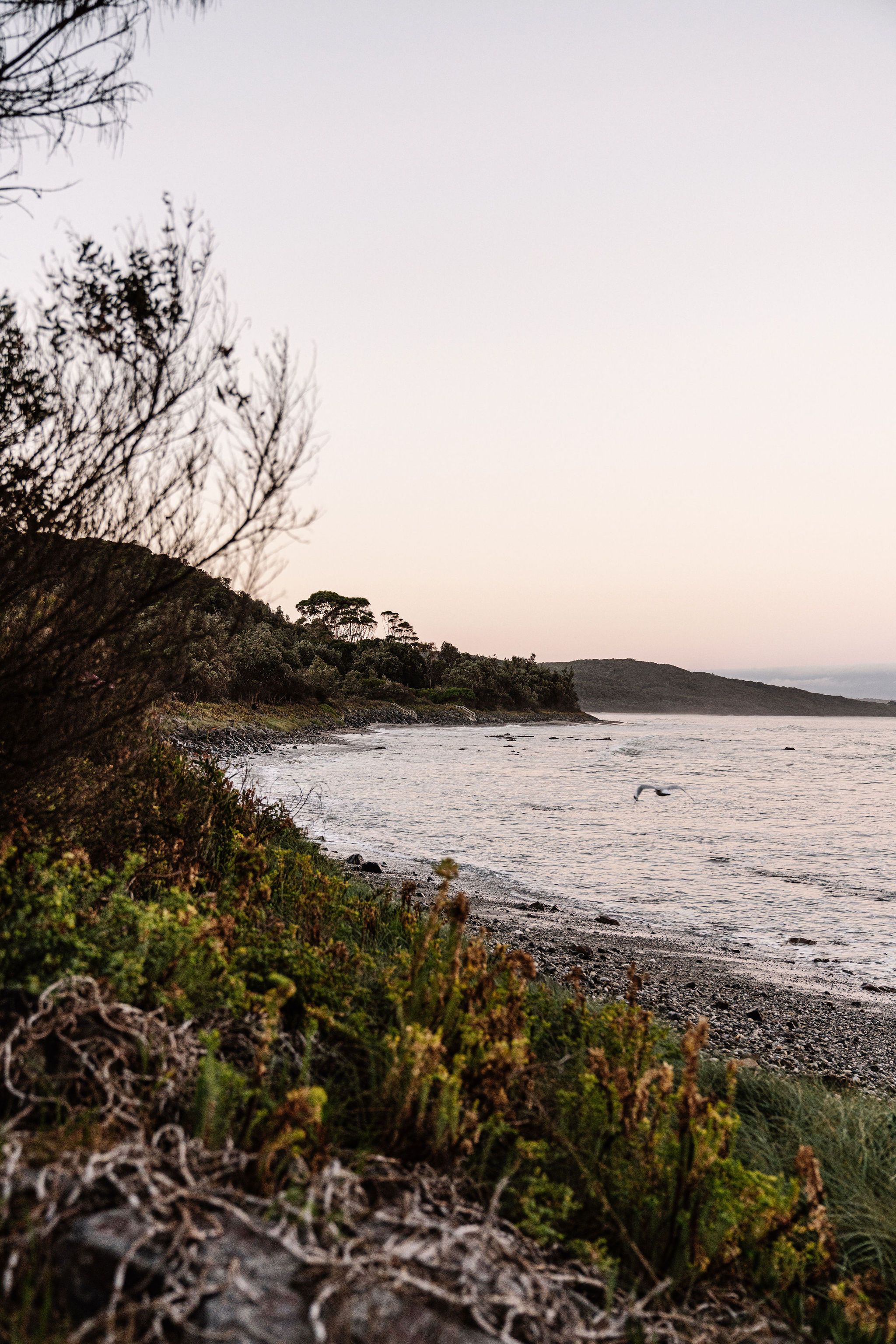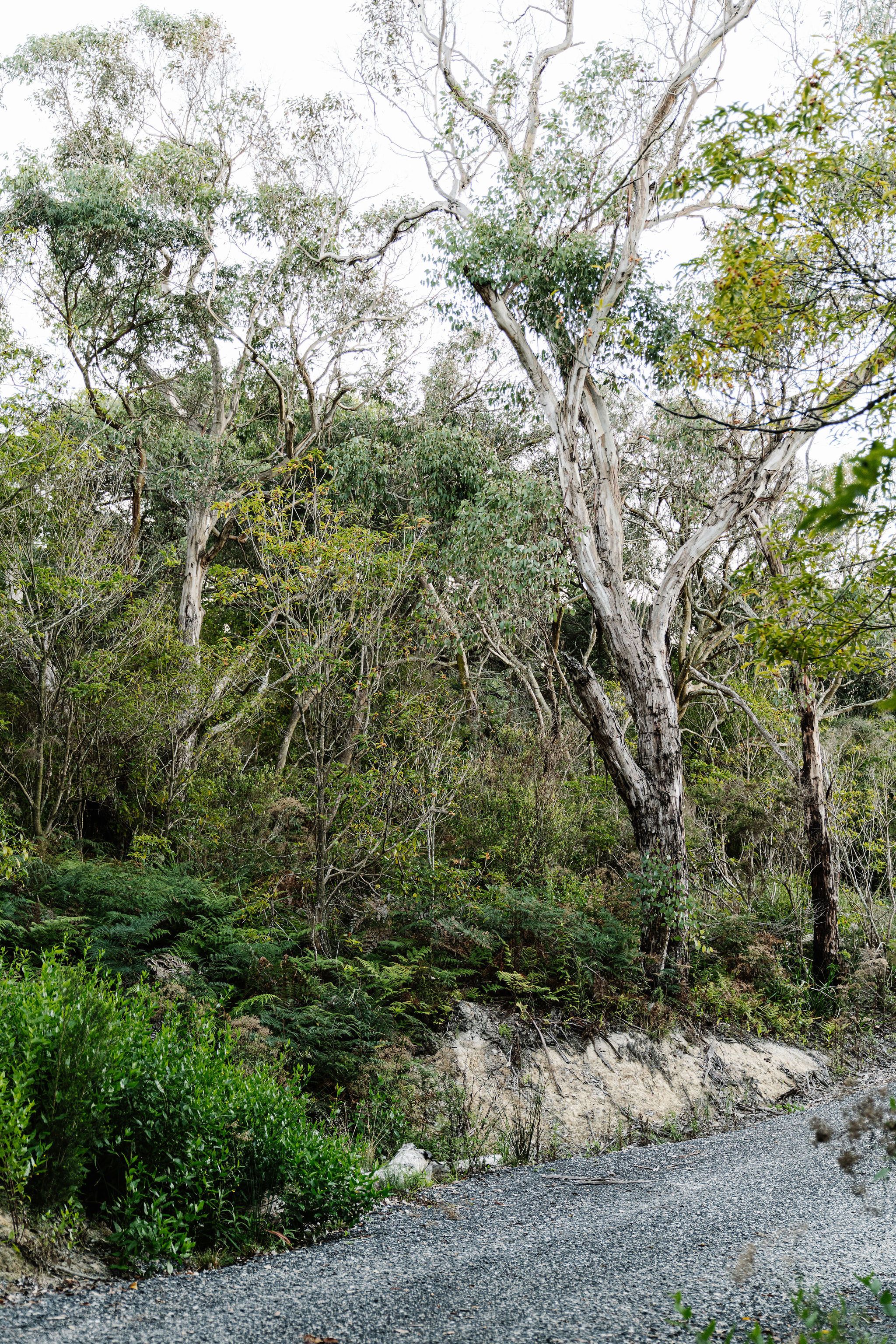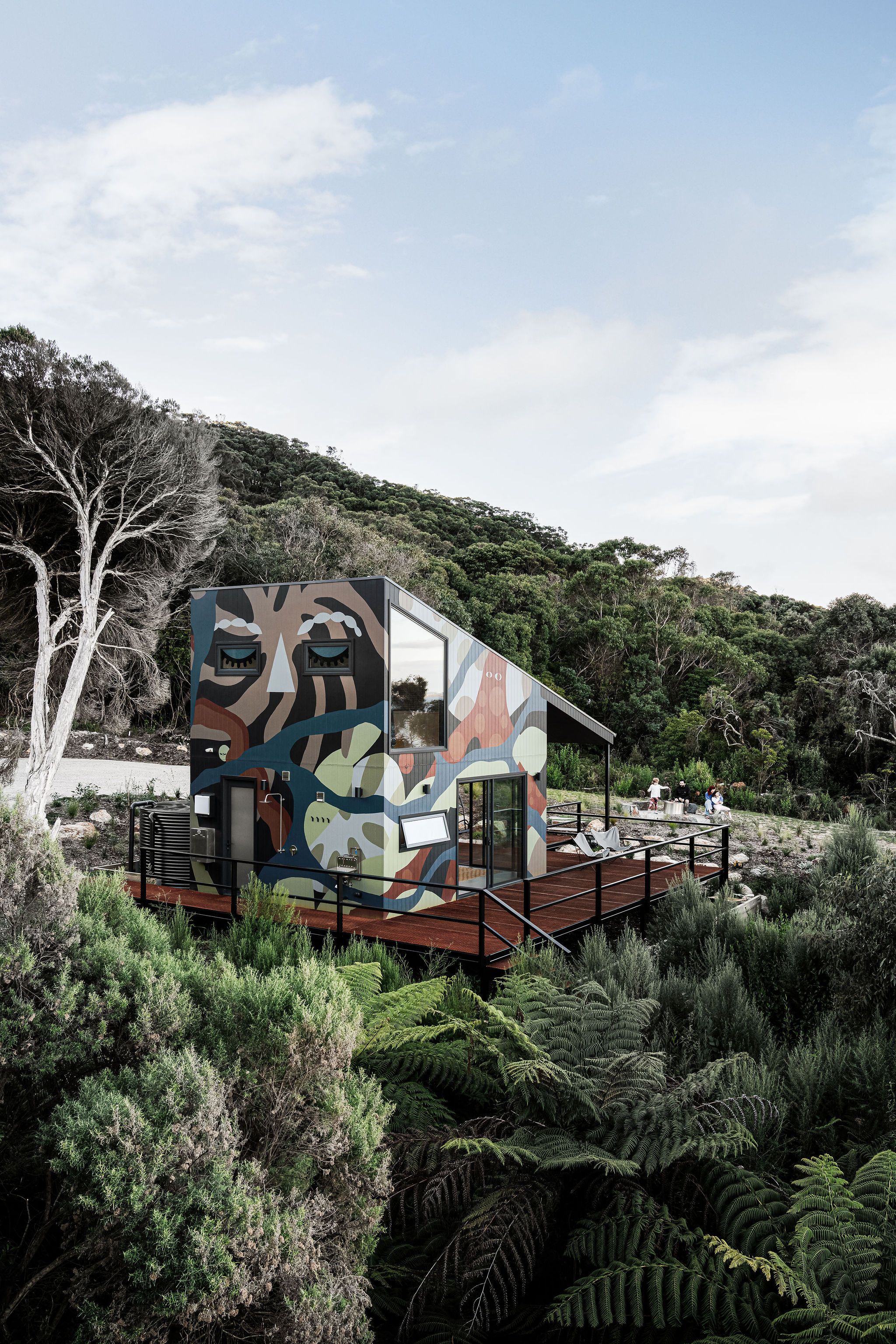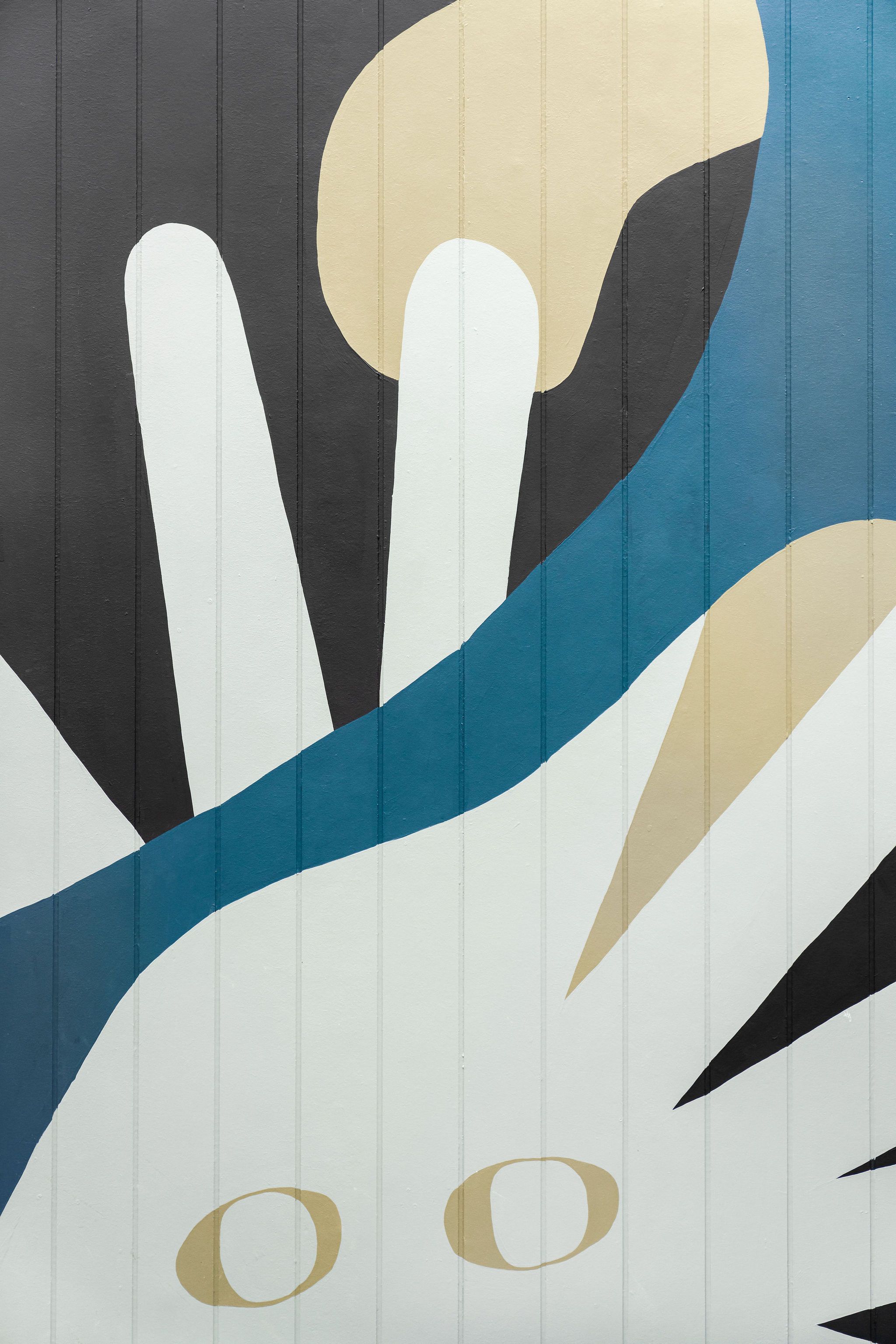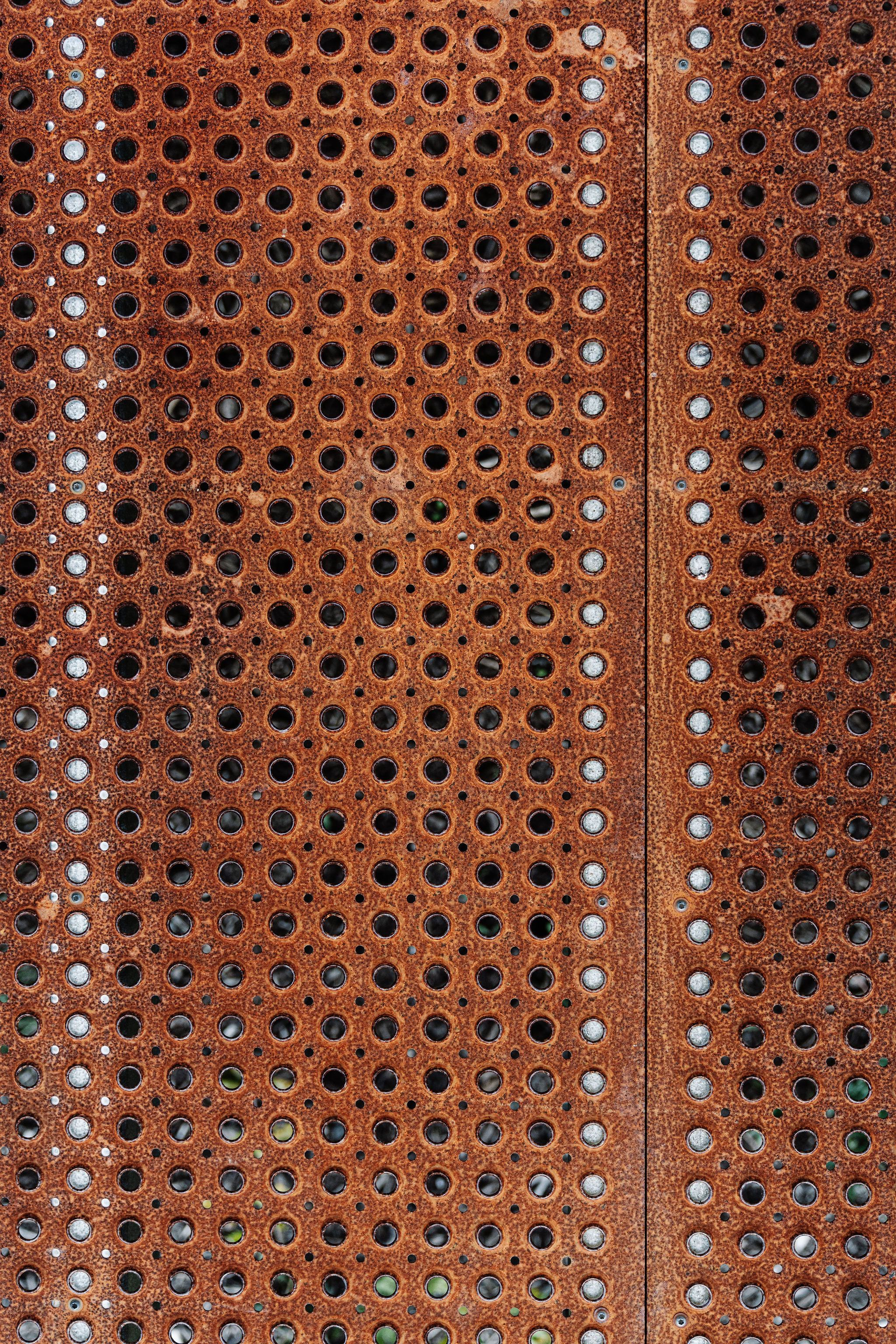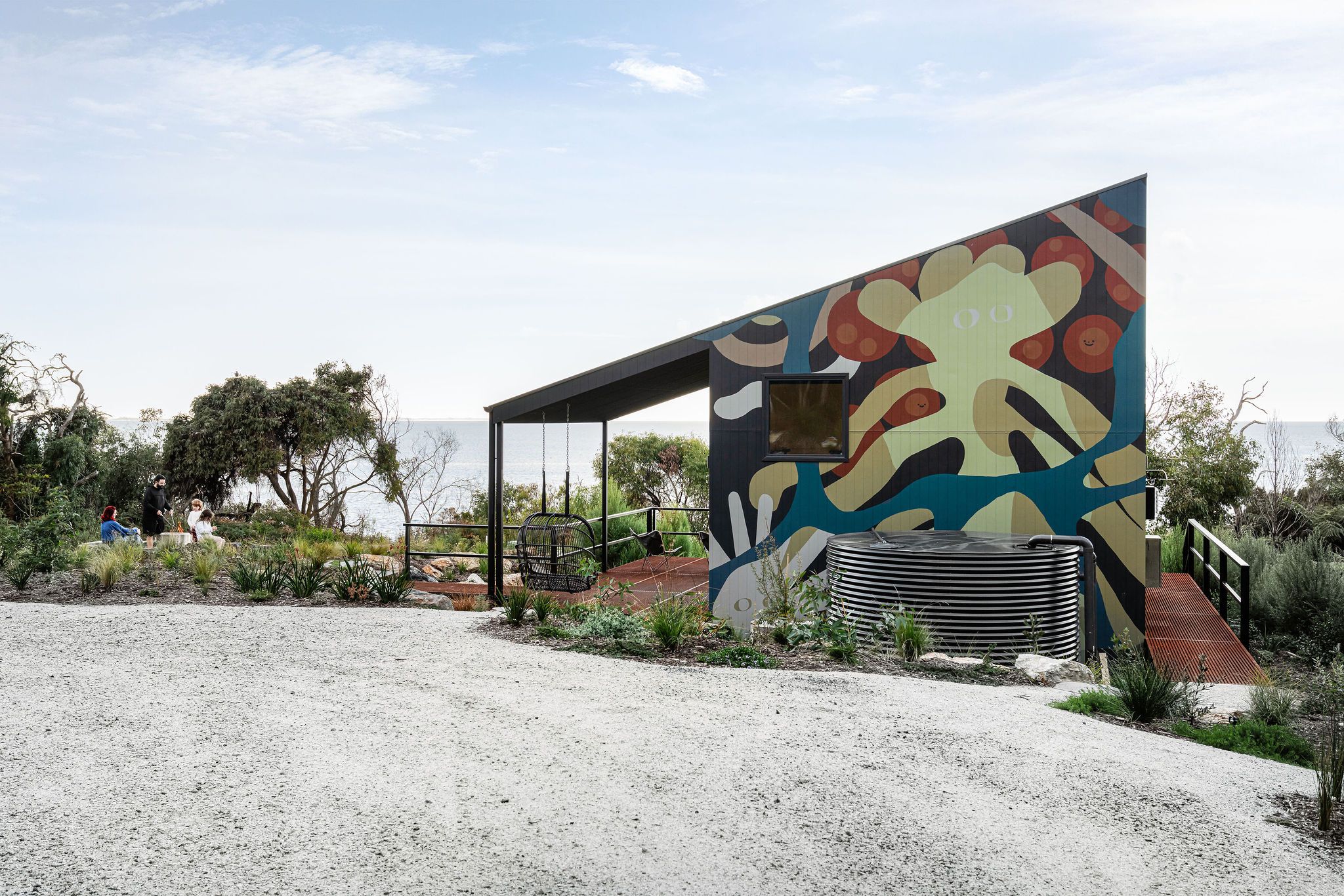Waters
Built directly on the shores of Walkerville, Jacky Winter Waters is just a three-minute stroll to the beach along a private track engulfed by native bushland.
The landscape surrounding Walkerville is breathtakingly unpredictable. At high tide, the points that protrude from the foam are only accessible to those brave enough to scramble across the rocks. At low tide, the harsh landscape is replaced by a long stretch of gentle possibilities — beaches to comb, rockpools to scavenge and secret caves waiting to be explored.
The bushland that directly surrounds Jacky Winter Waters is a sanctuary for a wide variety of native flora and fauna. Follow the private track leading away from the house and you’ll reach the Walkerville North boat ramp in just three minutes – you’re very likely to catch sight of a koala along the way! If you continue on at low tide, Walkerville South is just ten minutes further.
The exterior mural wrapping all four sides of Jacky Winter Waters — floor to ceiling — embodies both the power of and beauty of its environment. The soft colours and gentle characters rip through the harsh surrounding bushland, and provide respite from the rocky coast. Celebrated amongst locals, one of the characters can be seen peeking out through the treelines from the street level below.
The south wall of the house has been specifically designed to appear as a face, with the two windows acting as eyes. This was inspired by ‘the eyes of Buddha’ that adorn most traditional Buddhist stupas — a direct homage to the contemplative work Jacky Winter Waters has been designed to encourage and support.
Artists' Statement—
Deep Drift
Deep Drift is an artwork by April Phillips, Beci Orpin, Carla McRae and David Booth. With each artist providing their own sketches and elements to start, the collaborative process flowed through shared trust and a visual conversation, passing images back and forth through various remixes and iterations, ‘jamming’ together in software until one total work was created. The result is Deep Drift, a hand-painted mural that wraps 360 degrees of the exterior surface of the property with gently undulating characters, motifs and colours, referencing and embodying the beauty of the surrounding environment, situated on Boon Wurrung country.
Deep Drift describes a lively world that exists both in that salty water and within ourselves, one that sweeps and sways in the constant flow of change. A hidden world that can only be discovered by diving deep to meet the big seaweed friends, spiky spinning fellas, mossy mollusks — curves of living memory, organic and oceanic. To go deep, deeper, downwards is to find that place beneath the surface, the inner sanctum. The discovery of a still space to rest beneath the clutter and clash, and to finally look calmly upwards and outwards beyond the ever-shifting surface.
The Artists
April Phillips is a Wiradjuri-Scottish woman of the Galari peoples. Her arts practice is cemented in digital arts; illustration, VR + AR research and in her role as a peer mentor for the next generation of artists. April leans into character design as a narrative tool to explore empathy, fun and form. Her use of vivid colour and unlikely digital processes celebrates the potential of computer art for a new world.
→View more of April's WorkBeci Orpin is a creative practitioner based in Melbourne, Australia. Her work occupies a space between illustration, design and craft. Beci has run her studio for over 20 years, catering to a wide range of clients including Facebook, Disney, Google and Uniqlo. Beci also exhibits her work both locally and internationally. She has authored and illustrated four D.I.Y books and four children’s titles. Her work is described as colourful, graphic, bold, feminine and dream-like, and she has been referred to as a ‘national treasure’.
→View more of Beci's workCarla McRae works as both an artist and illustrator across multiple mediums, such as drawing, digital illustration, sculpture, installation, murals and publications. With her signature blend of both detail and minimalism she creates bright, colourful work with bold forms and fine lines. Thematically her work often explores the realm of emotions, evoking hope, happiness and optimism through dynamic and playful visual narratives.
→View more of Carla's workDavid Booth, who also works under the pseudonym Ghostpatrol, is a Hobart-born, Melbourne-based artist whose practice shifts between studio works, site specific installations, commissioned murals and commercial design. His work has been exhibited at and acquired by several leading institutions including the National Gallery of Australia, Art Gallery of South Australia, National Gallery of Victoria and Parliament House Art Collection.
→View more of David's workin 2025 we added a permanent Homecamp 5m Bell Tent to accomodate an extra two adults.
in 2025 we added a permanent Homecamp 5m Bell Tent to accomodate an extra two adults.
Landscapers' Statement
My first visit to Walkerville was during a long, hot summer when our kids were small. We took them to the ‘Magic Beach’, a truly special place remote from the rest of South Gippsland with amazing views, pristine beaches and a wonderful diversity of native flora and fauna. South Gippsland is, by far, my favourite place in Victoria. Karl and I and our three children have spent our summer holidays there for more than 15 years and dream of moving there one day. So, when we were asked to design and build a garden for Jacky Winter Waters, the recently constructed Contemplative Residency House in Walkerville North designed by esteemed architect Imogen Pullar, we were beyond excited.
Driving to our first site visit, we passed through a dense forest of striking eucalypts, including E. willissii, E. ovata, E. radiata and E. kitsoniana, rough tree ferns (Cyathea australis) and beautiful woodland species like Pultaneaea daphnoides, Pomaderris aspera and Indigofera australis. Then, as the ocean and Wilson’s Promontory came into view, we saw some of our favourite coastal plants: Banksia integrifolia, Myporum insulare, Allocasuarina vertcillata, Correa alba, and many more. This local plant biodiversity became the framework for our design.
The site is situated on a small road winding up into indigenous heathy woodland and damp forest, with views and paths right down to expansive beaches and Waratah Bay. The neighbouring properties feature gardens sympathetic to the surrounding native bush; most have been carefully cleared while retaining many indigenous species. The house sits on a slope between two small fern gullies, with a eucalypt forest behind and ocean and Prom views out the front.
The steep site presented challenges in construction and in creating visual and functional connections between the house, garden and surrounding woodland. Excavation of the slope impacted the surrounding land, particularly its soil and water flow, causing erosion through the centre of the property.
To allow water flow, we created a dry creek bed and rockery around the outside of a perforated deck surrounding the house on three sides, with elevated walkways to higher ground. Due to bushfire risk, we needed a fireproof material that related to the house’s architecture and materials. We used perforated Corten steel, such as is used on ship decks and elevated bushwalking trails, to create an expansive entertaining and outdoor living area. The deck’s perforations allow a garden of Viola hederacea, Dianella tasmanica and Polystichum proliferum to grow underneath and remain visible. The rusty orange of the Corten steel complements the mural on the sides of the house, the garden’s rockery, and the many indigenous plants with warm yellow and rusty-toned flowers and foliage. The deck also features an outdoor shower amongst the tree ferns; a spectacular place to shower after a swim.
Beside the house, we planted a native lawn (Microlaena stipoides), which the local wallabies graze on (this will hopefully keep them from eating the garden plants!). The lawn features a boulder fire pit, while nearby shed and car park/camper areas were created using locally sourced gravel. We built a rockery from locally quarried mudstone, which has an incredible mix of rusty oranges, blues, yellows and greens, unlike any I have seen before.
We surrounded the house with feature plants, including dwarf Banskias (B. ‘Birthday Candles’, B. blechnifolia, B. sentinel), Anigozanthos (‘landscape tangerine’), Adenanthos “Broze Glow’, Xerochrysum viscosum, Chrysocephalum apiculatum, Grevillea gaudichaudii and Grevillea lanigera ‘Mt Tamboritha', Casuarina (‘Cousin It’), Pimelea nivea amongst indigenous species. We added local grasses and rushes (Poa poiformis, P. labilarrdierii, Themeda triandra and Ficinia nodosa) and wildflowers (i.e Wahlenbergia stricta and Buchardia umbellata) in large swathes to allow pioneer plants to become established. We also planted some smaller trees, such as Leptospermum brachyandrum ‘Silver’, B. marginata and a copse of Eucalyptus gregsoniana, along with a coastal manna gum feature tree (E. pryoriana). This milieu connects the garden to the surrounding bushland while allowing glimpses of the incredible coastal views.
Local wildlife frequented the garden as we created it, including a tame little echidna and a resident wombat that happily grazed and dug into the earth. Wallabies keep the lawn mown, while numerous birds maintain a bush chorus. As the garden grows, the house will continue to nestle further into the landscape. We hope that our design, inspired by our love of South Gippsland, provides refuge and ongoing inspiration to contemplate or create.
Lori McNutt
McNuttndorf Landscape Design




